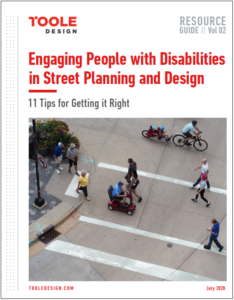Engaging People with Disabilities in Street Planning and Design (11 Tips for Getting it Right)
Project Summary
Despite the United States’ Americans with Disabilities Act legislation, people with disabilities are often routinely still left out of street planning and design processes and many streets and public spaces still aren’t fully accessible. There are too many streets and public spaces that fall short of actually providing a safe and comfortable experience for people with disabilities—even if they do meet the letter of the law, standards, or relevant guidelines. If we aren’t proactive about engaging people with disabilities in planning and design processes we are very likely to overlook or misunderstand their needs, particularly when the needs are not codified in official standards and guidance, which is often the case, especially for less conventional street designs.
We developed a new resource guide that is a compilation of the most important lessons we’ve learned about engaging people with disabilities. Inside, you’ll find the following:
- A clear overview of why it’s so important to engage people with disabilities in street planning and design processes
- 11 practical tips for engaging people with disabilities
